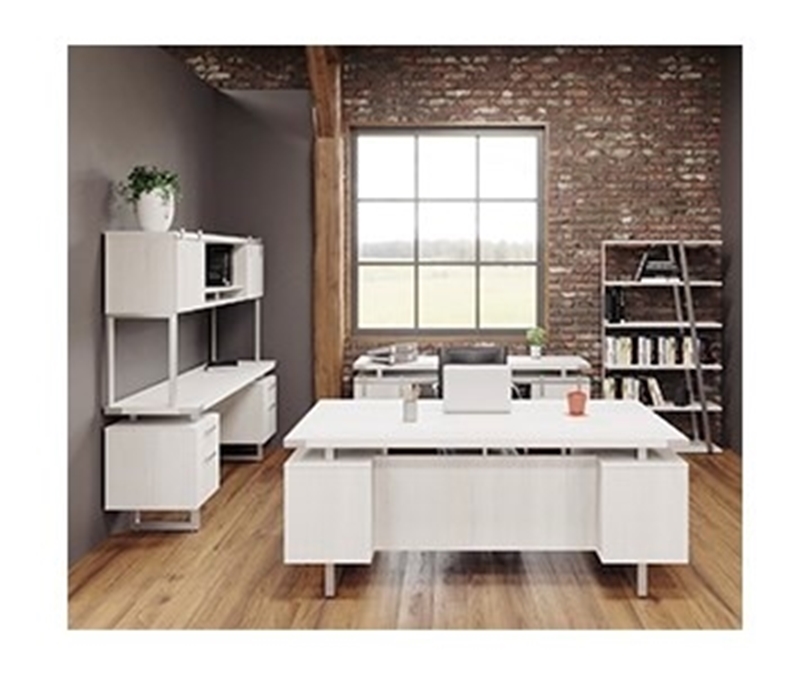Furniture Evolution

The work environment is always changing. Some of these changes are the result of time, some are caused by technological advances, and others through logistical changes. Centuries ago, long before the industrial revolution, people worked out of their homes or in small communities. Large companies and corporations really did not start forming until these small villages branched out. The invention of the telephone, the railroad, and electronics had a huge impact on how we do business and office designs drastically changed to fill the new need.
Early America
When Europeans first started to colonize “The New World”, settlements were created by starting up towns along the coast. These towns would have to farm or procure their own food or find some sort of valuable commodity to trade for some. People worked with what they had and no one was concerned with desks. People had workshops, tables, and tools designed for several different purposes. Working to them meant manual labor with the purpose of surviving. A blacksmith would have a forge, a baker would have an oven. They had simple chairs and didn’t have the time or need for extravagant furniture. The furniture design of this era was simple and functional, people didn’t have the time or need for luxury.
As the colonies began to thrive and grow so did the populations, which enviably changed what type of furniture people wanted and needed. Banks and trading posts opened and the need for administration facilities grew. As a result, traditional desks and chairs started to make their appearance. By then the colonies had some economic success and as population increased the amount of specialization increased as well. People could now focus on one skill and trade more easily for everything else. Towns became larger and more styles and options started to appear in the furniture world. Many places still used simple tables designed to be cheap and functional but more commercial places could afford better and did so to make an impression on clients. Additionally, North America’s vast forests ensured there was plenty of building material.
Railroad
The invention that really changed the way offices look and the furniture we used was the widespread growth of the railroad. The intercontinental railroad made crossing American fast and easy and enabled a whole new level of trade. However, with this new ability came a new need. Administrating a national railroad takes a lot of coordination and a lot of logistics. You cannot get the schedules wrong or a disaster like a crash could occur. As a result, we started to see things like standard time and new and improved communication start to take the forefront. These jobs involved a lot of calculations and a lot of coordination; and as far as workplace needs, people now sat still and worked at desks more often. Chairs needed to become more functional and comfortable and designed to be used for long periods of time. Additionally, we started to see the workplace as a whole change. People started to specialize even more and factories and distribution centers started to appear all over. This resulted in a more standard style workplace. People did not have the time or money to spend on fantasy handmade colonial style traditional furniture. Factories would produce affordable standard size pieces. They were cheaper but lacked the traditional quality and personal feel of older furniture pieces.
Communications
The telephone and the fax machine caused a major change in how we do business as well. The ability to trade with easily and discuss business across the country in live time was a game changer. Things could happen quicker and product could get to the end user faster. To process all these orders businesses needed large workforces around central lines of communication. This really created the need for office cubicles. Companies would want to cram workers together to maximize cost and efficiency. These desking systems needed to be modular and wired for phone and power, they were big business. Many major companies had great success selling these panel system style offices for a long time. There was a market for high end customer desks and furniture pieces as well. Company executives wanted their office to impress clients and the need for private office design styles grew as well. It was an era of success and growth for commercial furniture dealers. Then came the World Wide Web.
The internet really has changed everything. The demand for cubicles has been declining for years and we saw a rise in the open concept trend. People spent less time on the phone and did not need giant barriers between themselves and their coworkers. Offices were quiet as most day to day transactions now occur through e-mail. Offices have become more laid back and the formal look has declined as a result. Even the executive suites have started to look different. Traditional and formal styles are out of fashion and many offices are now trying to look homier. In reality, we have come full circle. We started by working out of our homes to survive, we then transitioned to a more industrial and commercial economy centered around larger workplaces, and now we are trying to make our offices feel more like home. Many of us even work from home, even prior to the COVID-19 pandemic.
We are now transitioning once again. Current times have forced people to work from home and when this ends, will large offices open and operate as they did before? Companies are learning they can save money by having employees work from remote locations. How will this impact modern office design? Will we see a shift to small functional workplaces designed for home or will we see large home offices become a must on a house hunters list? We can only wait and see.














































